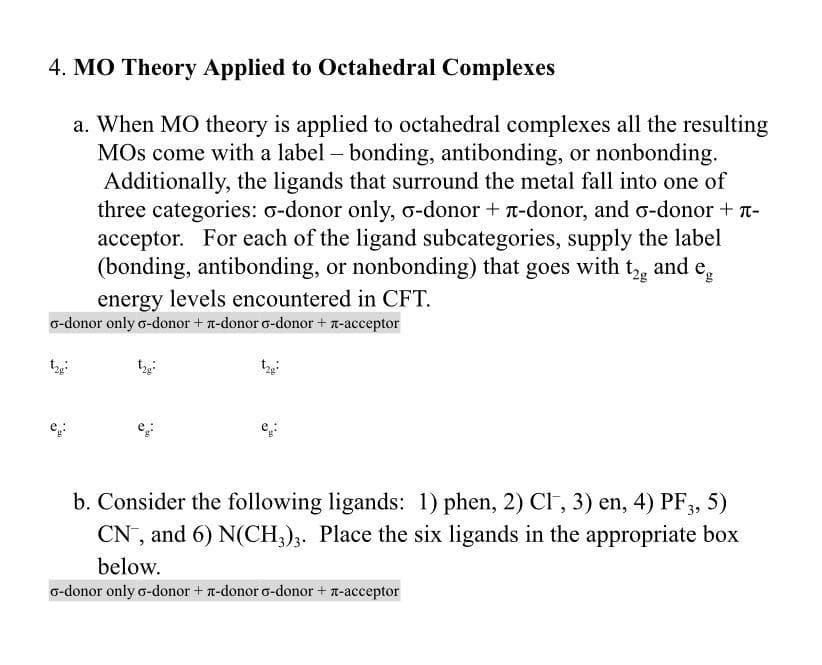4. MO Theory Applied to Octahedral Complexes a. When MO theory is applied to octahedral complexes all the resulting MOs come with a label- bonding, antibonding, or nonbonding. Additionally, the ligands that surround the metal fall into one of three categories: o-donor only, o-donor + n-donor, and o-donor + T- acceptor. For each of the ligand subcategories, supply the label (bonding, antibonding, or nonbonding) that goes with t,, and e, energy levels encountered in CFT. 0-donor only o-donor + n-donor o-donor + n-acceptor b. Consider the following ligands: 1) phen, 2) CI, 3) en, 4) PF3, 5) CN, and 6) N(CH,)3. Place the six ligands in the appropriate box below. o-donor only o-donor + n-donor o-donor + n-acceptor
4. MO Theory Applied to Octahedral Complexes a. When MO theory is applied to octahedral complexes all the resulting MOs come with a label- bonding, antibonding, or nonbonding. Additionally, the ligands that surround the metal fall into one of three categories: o-donor only, o-donor + n-donor, and o-donor + T- acceptor. For each of the ligand subcategories, supply the label (bonding, antibonding, or nonbonding) that goes with t,, and e, energy levels encountered in CFT. 0-donor only o-donor + n-donor o-donor + n-acceptor b. Consider the following ligands: 1) phen, 2) CI, 3) en, 4) PF3, 5) CN, and 6) N(CH,)3. Place the six ligands in the appropriate box below. o-donor only o-donor + n-donor o-donor + n-acceptor
Chapter21: Transition Metals And Coordination Chemistry
Section: Chapter Questions
Problem 2RQ
Related questions
Question

Transcribed Image Text:4. MO Theory Applied to Octahedral Complexes
a. When MO theory is applied to octahedral complexes all the resulting
MOs come with a label- bonding, antibonding, or nonbonding.
Additionally, the ligands that surround the metal fall into one of
three categories: o-donor only, o-donor + T-donor, and o-donor + n-
acceptor. For each of the ligand subcategories, supply the label
(bonding, antibonding, or nonbonding) that goes with t, and e,
energy levels encountered in CFT.
o-donor only o-donor + T-donor o-donor + n-acceptor
b. Consider the following ligands: 1) phen, 2) CI , 3) en, 4) PF3, 5)
CN, and 6) N(CH,);. Place the six ligands in the appropriate box
below.
o-donor only o-donor + n-donor o-donor + n-acceptor
Expert Solution
This question has been solved!
Explore an expertly crafted, step-by-step solution for a thorough understanding of key concepts.
Step by step
Solved in 2 steps

Knowledge Booster
Learn more about
Need a deep-dive on the concept behind this application? Look no further. Learn more about this topic, chemistry and related others by exploring similar questions and additional content below.Recommended textbooks for you


Chemistry: An Atoms First Approach
Chemistry
ISBN:
9781305079243
Author:
Steven S. Zumdahl, Susan A. Zumdahl
Publisher:
Cengage Learning

Chemistry
Chemistry
ISBN:
9781305957404
Author:
Steven S. Zumdahl, Susan A. Zumdahl, Donald J. DeCoste
Publisher:
Cengage Learning


Chemistry: An Atoms First Approach
Chemistry
ISBN:
9781305079243
Author:
Steven S. Zumdahl, Susan A. Zumdahl
Publisher:
Cengage Learning

Chemistry
Chemistry
ISBN:
9781305957404
Author:
Steven S. Zumdahl, Susan A. Zumdahl, Donald J. DeCoste
Publisher:
Cengage Learning

Chemistry: Principles and Practice
Chemistry
ISBN:
9780534420123
Author:
Daniel L. Reger, Scott R. Goode, David W. Ball, Edward Mercer
Publisher:
Cengage Learning


Principles of Modern Chemistry
Chemistry
ISBN:
9781305079113
Author:
David W. Oxtoby, H. Pat Gillis, Laurie J. Butler
Publisher:
Cengage Learning